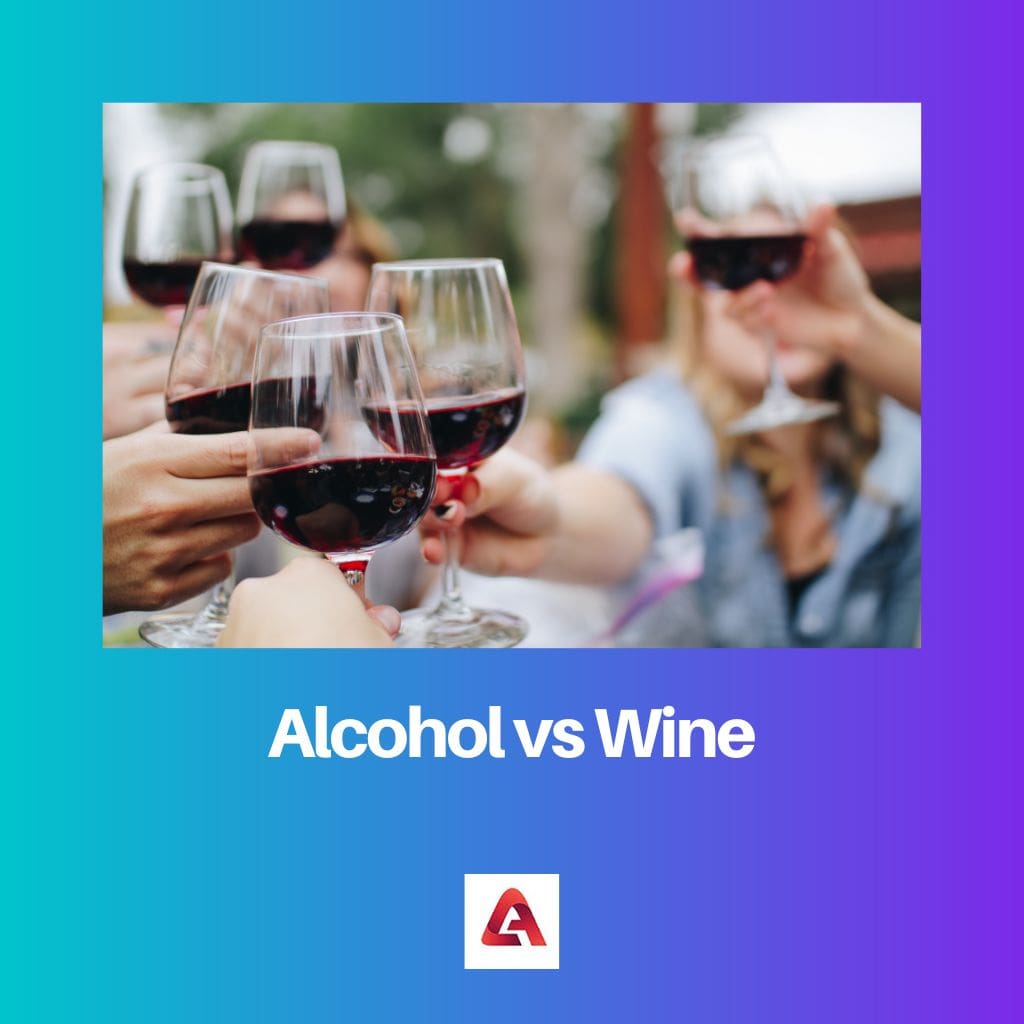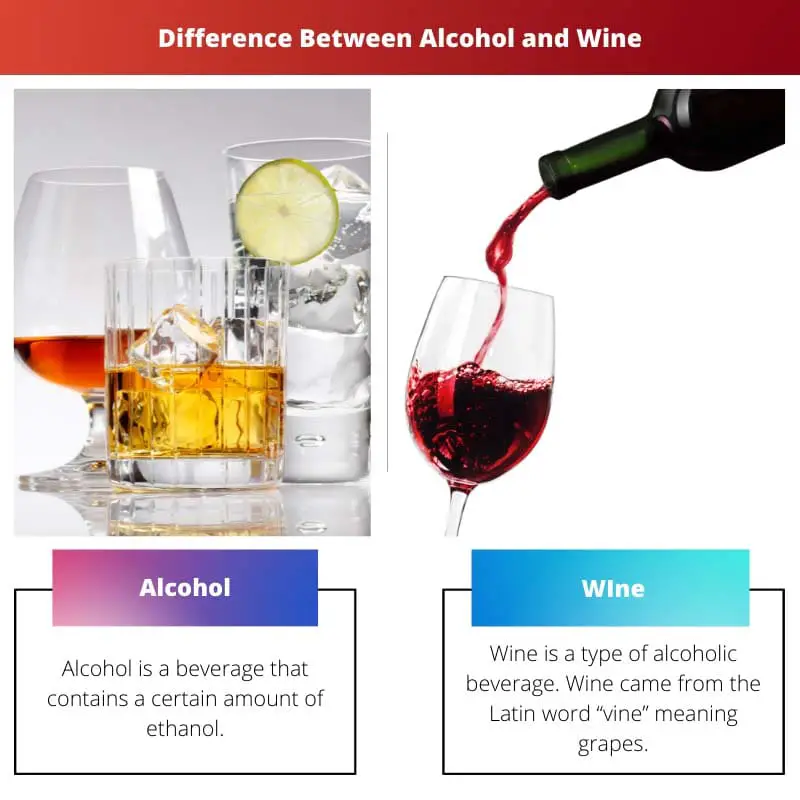Beverages are widely popular all over the world. Alcoholic beverage is one such thing that people bond over.
Alcoholic beverages are used for social relaxation and unwinding. Alcoholic beverage creates a unique ambiance for people.
If consumed moderately, alcoholic beverages can have certain health benefits, such as maintaining cardiovascular health and preventing diabetes by lowering blood glucose levels. On the other hand, excessive consumption of alcoholic beverages can result in side effects such as intoxication, liver disease, and cancer.
Key Takeaways
- Alcohol is a general term for a group of organic compounds containing one or more hydroxyl groups; wine is a specific alcoholic beverage made by fermenting the juice of grapes or other fruits.
- Wine contains alcohol due to fermentation, but not all alcoholic beverages are wine.
- Wine is available in various styles and flavours, such as red, white, and rosé, while alcohol encompasses a wide range of beverages, including beer, spirits, and liqueurs.
Alcohol vs. Wine
Alcohol is a fermented refined drink with no color, served with food or in cocktails. It is produced from grains and vegetables. Fermented grapes and no sugar are the main ingredients of a wine. Yeast in it converts sugar into ethanol and carbon dioxide. Its flavor and quality, depends on the type of yeast strains and type of grapes used.

The alcohol content in wine is relatively less than other alcoholic drinks, but it increases depending on the year of aging. Roughly estimated wine is 85% after and 12-15% alcohol.
Whereas for alcohol or liquor, the alcohol content may fluctuate depending upon the beverage. Alcohol is any beverage that has some content of ethanol.
Alcohol can be produced through various processes, such as fermentation and distillation. It can be classified under several groups, such as beer, spirit, and wine.
Wine, on the other hand, is a type of alcohol. It comprises the process of fermenting grapes, apples, cranberries, pomegranates, and plums.
It has less alcoholic content considered to other alcoholic drinks.
Comparison Table
| Parameter of Comparison | Alcohol | Wine |
|---|---|---|
| Alcohol Content | Varies depending upon the beverage | Relatively less alcohol content. Max 20% |
| Process | Distillation and fermentation | The process only involves fermenting fruits and then aging them in barrels. |
| Made form | It is made from all fruits, grains, and other food items | It is made from fruits |
| Value | It is valued for its intoxicating property | It is valued for its flavors |
| Kind | Spirit, wine, and beer | Red wine and white wine |
| Flavor | It does not have any flavor of its own | It is appreciated worldwide for its flavors |
| Versatility | All the alcoholics cannot be wine | All wines are alcoholic drinks |
What is Alcohol?
Alcohol is a beverage that contains a certain amount of ethanol. Alcohol can be obtained by the process of distillation or the process of fermentation of grains, fruit, and other food items.
Alcohol is a major part of the world and is important in social gatherings. It creates an ambiance generous enough for people to relax and socialize with each other in a carefree state.
Alcohol in low doses helps to combat anxiety and depression, whereas if consumed in excessive amounts can lead to multiple side effects such as intoxication, liver disease, and cancer. Alcohol can be classified into three types: beer, wine, and spirit.
The alcohol content will fluctuate from 3% – 50% depending upon the kind of beverage. Alcoholic beverages are used to prepare dishes as ethanol is a good dissolving agent for many fatty acids and essential oils.
It also provides a unique color and taste to the dish.

What is Wine?
Wine is a type of alcoholic beverage. Wine came from the Latin word “vine,” meaning grapes.
Wine is made from fermentation, where fruits such as grapes, plums, cherries, and pomegranates are fermented to obtain wine. Yeast is added to conserve the sugar in the fruits and convert it into ethanol, carbon dioxide, and heat.
Different variety of fruits results in different styles of wine. The alcohol content of wine fluctuates around 14%-15%.
The alcohol content for each wine varies in the year of aging. Wine is preferred worldwide for its unique flavor and taste.
Wine is used to set up a more casual and chill environment. As it is low in alcohol content, it does not intoxicate much and makes people enjoy the ambiance.
Wine can be classified into two kinds such as red wine and white wine. Red wine is made from red and black grapes. They are crushed and fermented for a few weeks, whereas white wine is made from white grapes; the skin and seed of the grapes are removed and mixed with yeast and left for fermentation in barrels for weeks.
Both these wines taste equally delicious and unique in their own way and have several health benefits, such as maintaining cardiovascular health and preventing diabetes.

Main Differences Between Alcohol and Wine
- The alcohol content in alcohol varies from a range of 3%-50% depending upon the type of alcoholic drink, whereas the alcoholic content in wine I relatively less it is around 15%
- Alcohol is made by distillation or fermentation, whereas wines are only made from fermentation.
- Alcohol is obtained from all food products, fruits, and grains; wine is only from fruits.
- Alcohol is valued for its intoxicating property as it is high in alcohol content, whereas wines are mostly valued for their unique flavor.
- Alcoholic drinks contain ethanol, which does not have a flavor until mixed with another substance, whereas wine is highly flavorful.
- All alcoholic drinks cannot be wine because wine is an alcoholic drink, whereas all wines can be classified under alcoholic drinks.

- https://www.sciencedirect.com/science/article/abs/pii/S0260877405006448
- https://academic.oup.com/jn/article/131/5/1401/4686863
- https://onlinelibrary.wiley.com/doi/abs/10.1002/clc.20263

The historical and cultural significance of alcohol and wine is deeply intertwined with human traditions and customs
Absolutely, the enduring presence of these beverages throughout history reflects their enduring influence on human social dynamics
The interplay of science, art, and culture in alcohol and wine production signifies the depth of human creativity and innovation
Absolutely, the craftsmanship and ingenuity involved in crafting these beverages reflect the resilience and ingenuity of human societies
The rich tapestry of historical and contemporary influences on the evolution of alcohol and wine highlights the depth of human knowledge and tradition
Alcohol’s versatility in culinary applications further highlights its significance in various cultural cuisines
The integration of wine and spirits in culinary creations showcases the depth of flavors that alcohol contributes to gastronomy
Absolutely, the use of alcohol as a flavor-enhancing agent in cooking and baking demonstrates its multifaceted nature
The process of winemaking is truly fascinating, transforming fruits into a flavorful and aromatic beverage
Absolutely, wine production is a delicate art that results in a wide variety of appealing flavors and styles
Despite the potential health benefits of moderate alcohol consumption, the risks of excessive drinking should not be overlooked
Indeed, promoting moderation is crucial as excessive alcohol consumption can lead to detrimental health effects
It’s intriguing how the fermentation process contributes to the distinct flavors of wine, making it a popular choice for many
Yes, the unique flavors derived from different fruits and fermentation techniques make wine a versatile and enjoyable beverage
I’ve always been fascinated by the art of winemaking and the nuanced flavors that result from the fermentation process
The societal value of alcohol and wine in fostering social connections and celebrations cannot be understated
Indeed, these beverages play a significant role in bringing people together and enhancing communal experiences
The consumption of alcoholic beverages has been a social and cultural phenomenon throughout history, promoting social interactions and a relaxed environment
I agree, alcohol is used as a social lubricant in many cultures, bringing people together in a carefree state
The duality of alcohol as a source of relaxation and a potential health risk necessitates a nuanced understanding of its role in society
Indeed, appreciating the complexities of alcohol consumption requires careful consideration of both its benefits and risks
The variabilities in alcohol and wine production processes underscore the complexity of these beverages and their cultural importance
Absolutely, the diverse methods of alcohol and wine production yield a rich array of flavors, colors, and textures